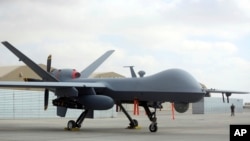Houthi rebels have shot down a U.S. drone that was flying over the Red Sea, a U.S. official told VOA.
The Iranian-backed Houthis reported the downing in a statement earlier Wednesday.
"Our air defenses were able to down an American MQ-9 while it was carrying out hostile surveillance and espionage activities in Yemeni territorial waters as part of American military support for Israel," the group said.
Last month, the destroyer USS Carney shot down multiple missiles and drones that were launched from Yemen by the Houthis. The Pentagon says they were "heading along the Red Sea, potentially toward targets in Israel."
The Middle East has been a tinderbox since Hamas launched an attack on Israel on Oct. 7, killing at least 1,400 people while taking more than 200 others hostage. Israel’s retaliatory strikes and ground offensive has caused more than 10,000 Palestinian deaths.
The U.S. has increased its presence in the region to protect its forces and to deter malign actors including Iran and its proxies the Houthis, Hezbollah and others from expanding the Israel-Hamas conflict.
Iranian-backed forces have targeted U.S. forces in Iraq and Syria at least 40 times in less than a month, according to defense officials. Most of these attacks were disrupted by the U.S. military or failed to reach their targets, causing no casualties or damage to infrastructure, the defense officials said.
The attacks have injured 46 U.S. military personnel, with injuries ranging from traumatic brain injuries to shrapnel or perforated eardrums.
The American injuries occurred during four attacks: a drone attack at al-Harir Air Base in Irbil, where the drone crashed before exploding; two multidrone attacks at al-Asad Air Base in western Iraq, and a multidrone attack at al-Tanf garrison in Syria.
All wounded personnel returned to duty following their injuries, Pentagon press secretary Brigadier General. Pat Ryder told reporters on Monday. However, two U.S. personnel who had been treated for traumatic brain injuries and originally returned to duty were subsequently sent to Landstuhl Regional Medical Center in Germany for further examination “out of an abundance of caution,” Ryder said.
One U.S. contractor at al-Asad Air Base in Iraq suffered a cardiac episode and died while sheltering in place during a false alarm for an air attack.
Nearly half of the attacks against American personnel came after U.S. forces carried out retaliatory strikes on a weapons storage facility and an ammunition facility in eastern Syria last month, which the Pentagon said had been used by Iran's Islamic Revolutionary Guard Corps and affiliated groups.
Several lawmakers last week raised concern that the military’s first response to the attacks in Iraq and Syria wasn’t strong enough.
"If we do not have a credible … deterrence with Iranians, these attacks are going to escalate. They're going to come faster, they're going to spread beyond Syria and Iraq, and they will involve weaponry of increasing sophistication and legality. That is my biggest fear," Republican Senator Marco Rubio said Oct. 31 during a Senate Appropriations Committee hearing.
"If this doesn’t stop, then we will respond," Secretary of Defense Lloyd Austin said while testifying during that same hearing last Tuesday.
The U.S. has deployed more than 1,200 troops to the region to protect U.S. forces in Iraq and Syria and to be prepared should Iranian-backed enemies try to broaden and expand the conflict in Israel. These units include a Terminal High Altitude Area Defense battery, Patriot batteries and Avenger batteries.
The USS Eisenhower carrier strike group, the USS Ford carrier strike group and other ships are patrolling in waters nearby.







